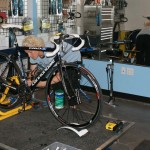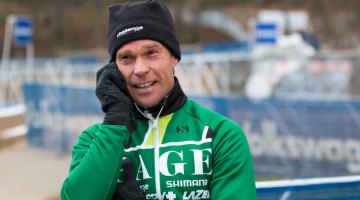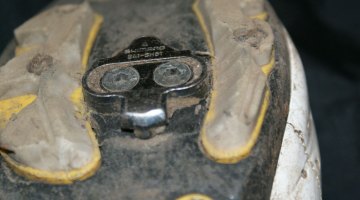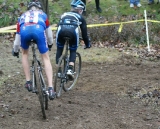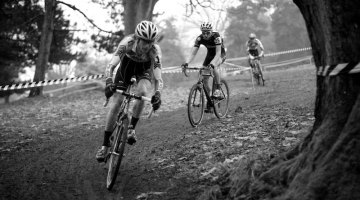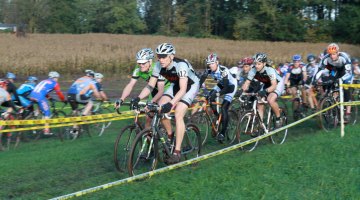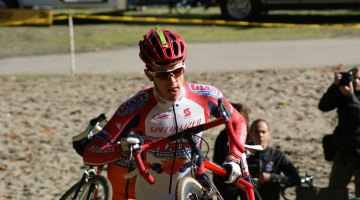Not sure if you’re training effectively? Have some ambitious goals for the season but feel like your racing has plateaued? Cyclocross Magazine’s Kenton Berg has been stuck in this situation but this summer he’s been motivated to do something about it and decided to seek professional help. Follow Kenton this season as he brings Cyclocross Magazine’s online readers along for a season of training and racing under the watchful eye of a coach. Kenton joins our growing group of columnists (including Christine Vardaros and Ben Popper) with this new semi-weekly online column. This is his second entry. Read his initial entry here
So I’m back to provide an update now that I’ve signed up to be coached, scrutinized and reduced to a subset of numbers and values. I had a chance to sit down with Coach Kristi and get busy. So we met at the CycleU facility and to go through a few details before all the suffering and number crunching would begin.
Our first item of business was to do what’s called a “spin scan.” My bike was set up on an indoor trainer that had a few more wires on it than a standard trainer. The wires would ultimately put out information on my cadence, whether I was dominant on one leg versus the other, or quad versus hamstring, and also would check my wattage. The goal of this was for Kristi to get an idea of how efficiently I pedaled (or not) and to assess whether I had leg imbalances. After spinning for about 25 minutes with the computer gathering the data the results were in…my efficiency was good, not great, and I was pedaling without any noticeable differences between the left and right legs.
Good news indeed, but the real interesting piece of information was that, like many of us mashers out there, I was overusing my quads and not engaging the hamstrings enough. The long-term effect of this type of pedaling is quad fatigue and loss of power during a race. So I have some work to do on using my hamstrings more (pulling through the pedal stroke vs. mashing the pedal) and creating a better pedal stroke.
Then it was on to reviewing the Training Peaks software that Kristi would be using to monitor my data (analyzing power files produced by my Saris Power Tap hub) and to view my daily/weekly/monthly training schedule. This software has become the standard for coaches throughout the country to use and incorporates some nice features that facilitate coach/rider interaction as well as allows the coach to continually monitor the progress of the rider. With every ride I will be doing, I will upload the power file into the software, allowing the coach to track my progress. The more data that is captured, the more accurate Kristi’s ability to measure my increases in performance as well as predict when I may be hitting a peak or over training.
As we reviewed my plan and how to use the software, Kristi was able to show me what a year’s worth of data looked like in another rider’s file. Once I saw that, it became very clear how the “graph of progress” might look in my case and how the coaches look for the peaks, valleys, and spikes in power output. Once again, this is the upside to being tied to that little yellow Power Tap computer on my handlebars!
Kristi and I also had some discussion regarding the use of the Power Tap for ‘cross racing and how and when to gather real race data. The challenge becomes sacrificing to race with the added weight of the Power Tap hub in order to obtain the information gathered during a race. The other concern is the risk of destroying an expensive hub and wheel during a race. Again, the upside of the power-based information has a potential penalty but we figured that doing one early season race in good weather was going to be a great way to set some race baselines and limit potential gear destruction.
So what insights did I get from our first session? Well, my initial fears about having to be tied to the power meter and its data were nullified once I saw how the data was to be used and how it can benefit the rider over time. If I’m consistent in doing the training and providing the data to coach Kristi, the outcome over time should be extremely beneficial.
Another concern I had going in was how to work in my regular rides with “the crew” as well as track racing into the overall game plan. But I was happy to realize my fears were unfounded. With a little discussion, Kristi was easily able to fit these group rides and races right into what I was looking to accomplish, and would continually make adjustments based on my data from these rides and races. Thankfully, the track racing plays nicely into cyclocross training as the short power bursts of the track play a huge role in cyclocross, while the group rides will serve nicely as recovery rides or endurance rides depending on the situation.
So, armed with a new sense of possibility, it’s time to hit the road and ride, race and begin some focused training and data gathering. Over the next few weeks I’ll be mixing it up with some longer rides, some big climbs (including preparing for and riding the Alpe D’Huez and Ventoux in September!) and some racing on the track and locally on the road.
Stay tuned as I check back in with my progress and the issues I encounter in trying to make the power-based coaching and training work. Thanks for reading!
If you have a question or comment, drop it below.














